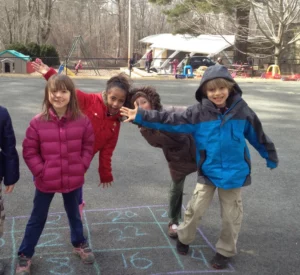 If you teach math, or want to enrich your children’s understanding of numbers, here is a set of activities that children will enjoy while learning a lot.
If you teach math, or want to enrich your children’s understanding of numbers, here is a set of activities that children will enjoy while learning a lot.
You may have heard about Multiple Intelligence Theory. One thing it tells us is that we evolved to have intelligence not only in verbal and mathematical learning, which are the main focuses in our schools, but in a number of different areas. That’s why some of us learn better through music, or nature, or art, or bodily movement.
This activity is a kinesthetic (movement-based) way to teach some important number facts. I’ve found that it increases math fact retention in everyone who plays it. One reason might be because it’s more engaging and fun than paper-and-pencil or verbal learning. Who learns well when they’re bored?
I made this project because I teach using Singapore Math, which is the best way I’ve found to teach math. However, the materials don’t focus on teaching basic facts; these are left to the teacher and/or supplementary programs. So I use lots of different activities and resources for teaching the facts; this is one of them.
Learning Objectives
After playing these games, students will be able to remember their basic addition doubles facts and squares (powers of two).
For this set of activities, you will need:
- Number mat OR sidewalk chalk
- (We’ll go into how to make the number mat in another step.)
- Space
- Number cards: Download squares card and/or addition card PDFs
Step 1 Outdoor Number Mats
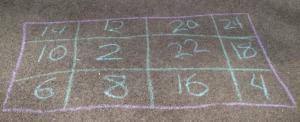
If you have access to asphalt, sidewalk chalk, and decent weather, this is a great activity to get your students outdoors and enjoying learning their math facts.
Just draw your chosen number grid according to the layout in the PDF file, and print and cut out the cards. Instructions for playing the games come in step 3.
Step 2 Indoor Number Mat
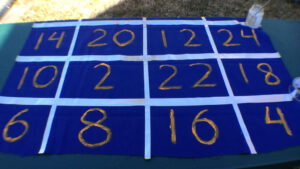
This step shows you how to make the Indoor Number Mat. This is a versatile tool to have in your classroom; keep it around for bad weather, and your students may even want to pull it out during recess! You may get some great ideas from them for how to use it.
For this project, you will need:
- Large piece of fabric, Tyvek, or something else convenient (it could be a good way to recycle canvas used for a stage set). I think the minimum size is about 4′ x 5′.
- Fabric paint or acrylic
- Duct tape or ribbon
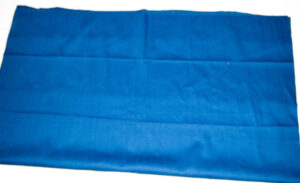 The first thing I did with my fabric was to fold it in half and see how to split it in twelfths. This was easy given the fold lines in my fabric. If you don’t have this, simply fold twice horizontally, and bring two folds to the middle to make your three. (See diagram.)
The first thing I did with my fabric was to fold it in half and see how to split it in twelfths. This was easy given the fold lines in my fabric. If you don’t have this, simply fold twice horizontally, and bring two folds to the middle to make your three. (See diagram.)
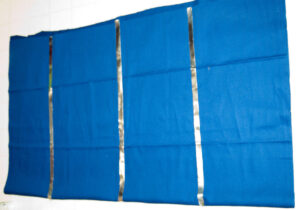 Now use your line-making option to “draw” lines along those folds. I used thinnish strips of duct tape for the vertical lines and the remaining fatter strips for the horizontal ones.
Now use your line-making option to “draw” lines along those folds. I used thinnish strips of duct tape for the vertical lines and the remaining fatter strips for the horizontal ones.
Next, paint the numbers according to the layout inside the boxes in the Grids PDF.
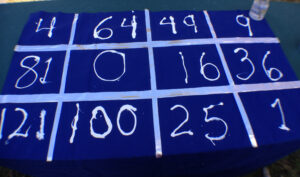
I chose to use the full length of my fabric and use the top half for squares, leaving the bottom half for addition doubles. I needed to do this partly because I was in a hurry at first and painted just by squeezing acrylic paint directly onto the fabric, so it bled through to the other side. I had planned to use the other side for something else, but that’s no longer possible. If you are more careful, though, or use fabric paint, you can use one side of a smaller piece for the addition and the other side for multiplication.
If you are using a fabric board, I recommend the children play on it with their shoes off.
Step 3 Games to Play
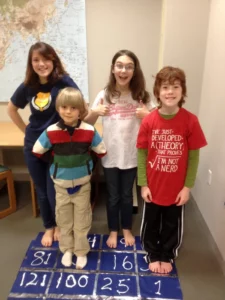
There are so many possible games to play with these boards. Here are a few I discovered on the first day I tried them with my students.
Doubles Fun Plus or Squares Jump
Note: The idea for the addition doubles jump game comes from Adrian Bruce, an Australian teacher with an awesome website, but all extensions, photos, files, and multiplication-related activities are mine.
1. Children line up.
2. Cards are shuffled. Each child picks a card and tries to solve the problem. If successful, child jumps to the number on the board.
3. Card is returned to the bottom of the pile, and another children gets to try.
4. Play continues until all children have been on the board and have had a chance to solve at least two problems.
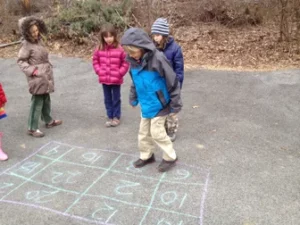
If you are working with a small group of children just learning these facts, have them retry problems they missed until they know them automatically. Not over and over again in a row so that it’s boring, but they won’t mind doing another problem and repeating one they missed a few times because they are having too much fun, in my experience.
Doubles or Squares Fun Around the World Hopscotch
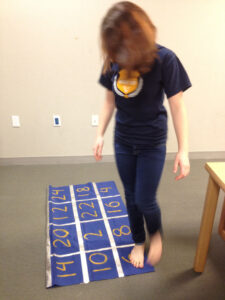 The idea of this game is to say the equations in order (e.g. “3 x 3 is 9, 4 x 4 is 16, etc.”) while hopping on the successive solutions. Teacher should model how to do this.
The idea of this game is to say the equations in order (e.g. “3 x 3 is 9, 4 x 4 is 16, etc.”) while hopping on the successive solutions. Teacher should model how to do this.
I think it’s important in this game that the student says the full equation aloud. This reinforces the equation in their automatic systems. I noticed that directly after the game, my students were using what they had practiced to solve problems.
For young children, once they have practiced with the equations, have them try counting by twos and jumping on the numbers in order.
Discussion Time
This isn’t a game, but an important part of developing the students’ metacognition (higher-level thinking) and discourse (math talk) about these computations. Ask:
- What do you notice?
- How can these facts help us figure out a problem?
- For example, if we know what 7 x 7 is, how can we use that to figure out 7 x 8?
- Do you notice any patterns?
- Where are the doubles the same in addition and multiplication, and where are they different?
- Can you see a pattern where some products are even and some are odd? What are the factors that make them that way? How is this similar or different from addition doubles?
- With young children, explore odd and even numbers on the addition mat, and then flip it over and have them identify odd and even numbers on the multiplication mat.
Allow the children to explore the concepts. It will make math a lot more meaningful to them.
This project was originally published on Instructables.com. It is all my original work.